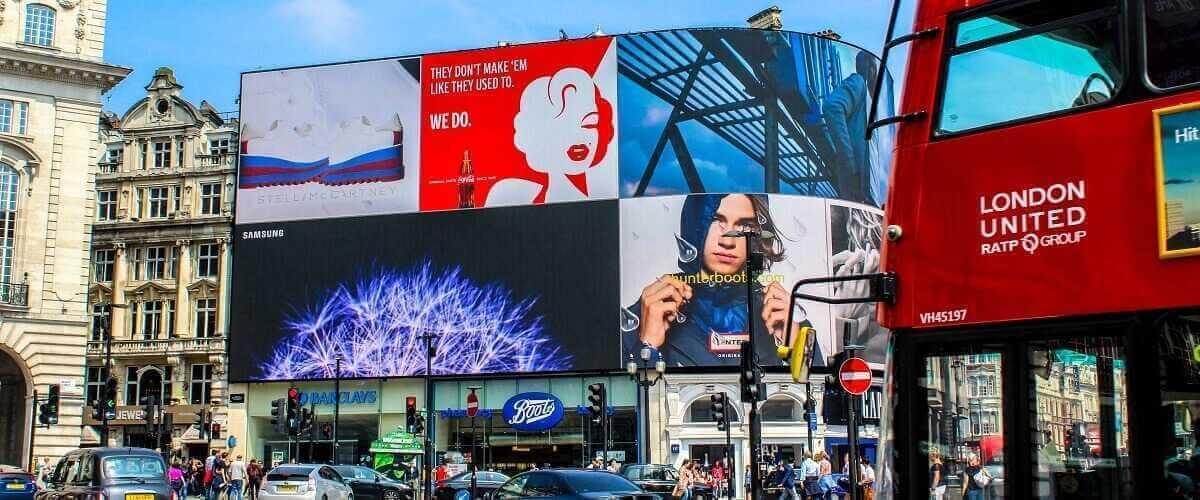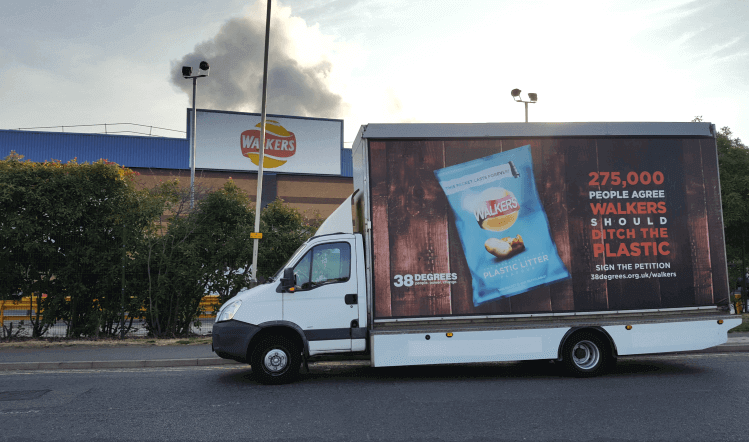
Online advertisements are not the ‘be-all-end-all’ of marketing. While the industry does account for a large percentage of the market and doesn’t plan on stopping there according to research that predicts a strong 8.4% compound annual growth rate from 2018 through to 2023, online advertising comes with just as many strengths as it does weaknesses. Customers have the ability to ignore ads, there are many common technical issues, and consumers can be distracted by the commonly highly-dense platforms. With these gaps in the effectiveness of online advertisement, the marketing industry has holes that need to be addressed.
The answer to these gaps can be found in a more traditional advertising format: mobile billboards. With out-of-home advertising rising in popularity, mobile billboards are being implemented into the average business’s marketing strategy, offering eye-popping, dynamic visuals that grab a consumer’s attention and build a company’s brand in ways that online advertisements could only wish for.

OOH is thriving
The growing popularity of mobile billboards can be attributed, in part, to the growth of the out-of-home advertising market as a whole. Businesses small and large are hopping onto the out-of-home trend – a trend which, through the years, has experienced growth without fail.
Out-of-home advertising represents a large share of advertising spending, representing $29 billion as of 2018 across key markets around the world. Research even shows that this number is increasing steadily: quarterly trend data on OOH since 2012 has shown almost consistent growth in out-of-home advertising spending (3.1% year-over-year growth in 2016, and 1.2% in 2017, and 4.5% in 2018).
Also, a sign of the market’s growth is that the companies investing in out-of-home advertising are not the declining companies with out-of-date practices. Apple, Google, Amazon, and Netflix, all tech firms, are among the 10 largest spenders on billboards.
Not only are these mega-businesses using out-of-home advertising, but they’re becoming owners. Companies like Netflix and Alibabe have recently made big investments in outdoor ad companies, while Google is reportedly introducing products for billboard and other outdoor advertisements.
The driving factor in the OOH growth: digital billboards. According to PricewaterhouseCoopers, digital outdoor ad spending has grown 35 percent since 2010 and 15 percent annually in recent years.
Why is out-of-home advertising thriving now?
The reason for the use of out-of-home advertising is simple: despite all the strengths of online advertising, when you want an ad to get special attention, you go with out-of-home.

The lasting impact of out-of-home advertisements
Out-of-home billboards create big impression for big amount of people. The impact associated with a large billboard in the right place, viewed by the right people, at the right time creates an impact that can’t be matched by online advertisements. Out-of-home advertisements are bold, dynamic visuals that consumers remember. Online advertisements, on the other hand, are commonplace, insignificant, and forgettable. Across all online ad formats and placements, the click-through rate is just 0.05%: that means five clicks per 10,000 impressions.
Unlike online advertisements, consumers don’t need to click a webpage or perform an action to see their advertisements – out-of-home advertisements are right where the consumers are, easily visible, and incredibly eye-catching. Additionally, out-of-home advertisements can’t be blocked, swiped, or deleted like online advertisements. In fact, in 2019, an estimated 25.8% of internet users used ad blocking programs on their connected devices – and this figure is expected to keep growing. If you want advertisements that 100% of consumers can see, out-of-home is the way to go.
Disadvantages of online advertising
Online advertising, though less costly and more personalized, can present many problems to consumers that can leave them with a frustrating and annoying experience – an experience they can associate with your brand. Online advertisements can be slow to load, can arrogantly and annoyingly interrupt a consumer’s internet use, and can easily be overshadowed by crowded websites and interfaces. On top of problems are the functionality of online ads, research suggests that consumers trust online advertisements the least of all formats.
Trust is everything when creating an effective marketing campaign, yet consumers nowadays trust ads less than ever: data from the Advertising Association shows that public favourability towards advertising has decreased from 50% in the early 1990s to just 25% in 2018. Research from Marketing Sherpa shows that online advertising has been indicated by consumers to be relatively less trustworthy than other formats, with pop-up advertisements being the least trustworthy. Conversely, print ads and outdoor advertisements were placed in the top five most trustworthy formats.

Why mobile billboard advertising in particular can bring your business success
Mobile billboards are an out-of-home format that creates direct exposure to drivers and pedestrians, reaches many more consumers than static billboards, and offers creative billboard designs that make your company stand out and your brand memorable. Here are just some of the benefits that mobile billboards can bring to any business in their marketing strategy.
Mobile billboard advertisements are memorable
According to the Outdoor Advertising Association of America, 98% of Americans indicated they notice media targeting vehicle drivers and passengers, including mobile truck ads and billboards. Psychology says that due to our continuous processing of information we receive from our senses, either consciously or subconsciously, the big billboard we see on the street or the road can be dramatic enough of an impression to trigger the familiarity principle in consumers later on. When asked, more than 75% of consumers who had witnessed an out-of-home advertisement in conjunction with other ad types recalled the brand a full 7 days later.
OOH-Mobile Integration creates exponential increase in reach
The development of a marketing campaign integrating out-of-home advertisements paired with mobile advertising has been shown to reap dramatic increases in all aspects of advertisement effectiveness.According to research from NinthDecimal, an out-of-home advertising campaign in conjunction with a smartphone campaign can amplify the reach by up to 316%.
This dramatic increase is in part due to a relatively new technology in the mobile billboard market. Now, a mobile billboard can be noticed by all the right people, in the right place, and at the right time due to the use of contextually relevant information advertised through proximity-based connection to surrounding smartphones.
Billboards are using geolocation data
Mobile billboard campaigns use geo-targeted out-of-home advertising, which triggers ads based on geographical proximity to an out-of-home advertisement.
Geo-location data allows advertisers to generate information that tells them the right targets for their advertisements, the best place, and the best time.
This location targeting is integrated through interaction with the associated mobile ads, store visitation, website traffic, and app downloads through a consumer’s mobile device, effectively providing the data media planners need in order to monitor their billboard’s performance. Partly due to the increase in mobile device usage, Thinknear states that the volume of location data doubles every 12 to 18 months.
Through the new mobile extension programs, commonly referred to as geofencing, advertisers have the ability to identify individuals who are exposed to their OOH ads and then retarget them with their mobile advertisements. Geofencing, the use of GPS or RFID technology to create a virtual geographic boundary, enables software to trigger a response when a mobile device enters or leaves a particular area. Its various performance indicators include:
Audience segmentation – targeting devices to target audiences based on demographics, browsing behavior and location
Geo-Conquesting – targeting devices who visit competitor locations
Geofarming – targeting devices who have visited specific locations in the past
Attribution – measuring the devices that were served an impression and later entered a physical location
This use of geo-location data is just for show – it’s generating dramatic results with the use of mobile billboards. Factual released a report stating that 83% of marketers say location-based advertising and marketing produced higher response rates, and higher customer engagement.
Mobile billboards are becoming trackable
Movia Media is a prime example of a company using mobile geo-targeting to maximize consumer interaction. With the use of onboard data analytics devices, Movia Media is able to track who comes in contact with their truck-side advertisements through relevant device ID measures within a certain radius of their trucks.
Moving advertisements get noticed
An ad that moves has a 45% higher peak exposure than stationary advertisements, according to a study by APN that used brain scanning technology. This higher level of exposure to the consumer creates a deeper level of memory encoding, leaving a consumer either consciously or subconsciously more aware of your brand.
Bigger is better
When it comes to billboard advertisements and size, no other advertising format can compare. Mobile billboard advertisements, generally spanning a truck side 10 feet high and 22 feet long, generate lots of attention with their hard-to-miss size. On top of the space they cover, mobile billboard advertisements are moving, and are at eye level. In a world of distraction and density, mobile billboards create enough clarity for their message to stand apart from the competition.

Billboards are becoming interactive
Owners of online businesses, however, may be skeptical of incorporating mobile outdoor advertisements into their marketing plans. These business owners, however, need to consider that 25% of people have had the opportunity to interact with an outdoor advertisement with their smartphone. Through advertising campaigns that use hashtags and interactive games, getting the consumer involved in the branding process is becoming more and more accessible.
Mobile billboards and commuting
While traffic has a commonly negative connotation, the opposite is true for your business and mobile billboards. 2019 reports have shown that the average resident in Toronto commutes 84 minutes per day – that’s 84 minutes daily, not including any extra traffic jams, that your mobile billboard will be in the faces of consumers. When it comes to face-to-face time, mobile billboards are in no rush.
Mobile billboards are effective geo-conquesters
One of the advantages of mobile billboards is that they are constantly on the move. As opposed to static billboards, mobile billboards can infiltrate the territory of competitors and draw attention away from their business to your own eye-popping billboard.

Mobile billboards are checked daily by a human being
Unlike static billboards, which receive little to no attention after installation, mobile billboards are under constant supervision, whether that be for results, or for safety. In order to ensure brand safety, many new fleet technologies have been developed:
- New turn-by-turn strategic routing systems
- Tablets for every unit which have audio GPSs
- Advanced GPS tracking for management teams
- Speed and hard brake alerts to help manage driver performance
- In-cab, side, and rear cameras to record critical safety events
- Improved campaign photo submissions
- Electronic submissions of pre/post-trip inspections and unit condition reports, allowing management to have faster access to maintenance issues
Conclusion
Despite the growing digitalization of the world around us, mobile billboards are as important in marketing campaigns now more than ever if your business is to stand out amongst the clutter of competition. If you want your business to maximize its marketing campaign, you need to incorporate mobile billboards into your strategy for maximum effectiveness in showing consumers the ‘big picture’ for your brand’s big impact.


